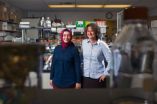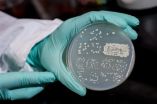(Press-News.org) The ability to accurately repair DNA damaged by spontaneous errors, oxidation or mutagens is crucial to the survival of cells. This repair is normally accomplished by using an identical or homologous intact sequence of DNA, but scientists have now shown that RNA produced within cells of a common budding yeast can serve as a template for repairing the most devastating DNA damage – a break in both strands of a DNA helix.
Earlier research had shown that synthetic RNA oligonucleotides introduced into cells could help repair DNA breaks, but the new study is believed to be the first to show that a cell's own RNA could be used for DNA recombination and repair. The finding provides a better understanding of how cells maintain genomic stability, and if the phenomenon extends to human cells, could potentially lead to new therapeutic or prevention strategies for genetic-based disease.
The research was supported by the National Science Foundation, the National Institutes of Health and the Georgia Research Alliance. The results were scheduled to be reported September 3, 2014, in the journal Nature.
"We have found that genetic information can flow from RNA to DNA in a homology-driven manner, from cellular RNA to a homologous DNA sequence," said Francesca Storici, an associate professor in the School of Biology at the Georgia Institute of Technology and senior author of the paper. "This process is moving the genetic information in the opposite direction from which it normally flows. We have shown that when an endogenous RNA molecule can anneal to broken homologous DNA without being removed, the RNA can repair the damaged DNA. This finding reveals the existence of a novel mechanism of genetic recombination."
Most newly-transcribed RNA is quickly exported from the nucleus to the cytoplasm of cells to perform its many essential roles in gene coding and expression, and in regulation of cell operations. Generally, RNA is kept away from – or removed from – nuclear DNA. In fact, it is known that annealing of RNA with complementary chromosomal DNA is dangerous for cells because it may impair transcription elongation and DNA replication, promoting genome instability.
This new study reveals that under conditions of genotoxic stress, such as a break in DNA, the role of RNA paired with complementary DNA may be different, and beneficial, for a cell. "We discovered a mechanism in which transcript RNA anneals with complementary broken DNA and serves as a template for recombination and DNA repair, and thus has a role in both modifying and stabilizing the genome," Storici explained.
DNA damage can arise from a variety of causes both inside and outside the cell. Because the DNA consists of two complementary strands, one strand can normally be used to repair damage to the other. However, if the cell sustains breakage in both strands – known as a double-strand break – the repair options are more limited. Simply rejoining the broken ends carries a high risk of unwanted mutations or chromosome rearrangement, which can cause undesirable effects including cancer. Without successful repair, however, the cell may die or be unable to carry out important functions.
Beginning in 2007, Storici's research team showed that synthetic RNA introduced into cells – including human cells – could repair DNA damage, but the process was inefficient and there were questions about whether the process could occur naturally.
To find out whether cells could use endogenous RNA transcripts to repair DNA damage, she and graduate students Havva Keskin and Ying Shen – who are first and second authors on the paper – devised experiments using the yeast Saccharomyces cerevisiae, which is widely used in the lab for genetics and genome engineering. The researchers developed a strategy for distinguishing repair by endogenous RNA from repair by the normal DNA-based mechanisms in the budding yeast cells, including using mutants that lacked the ability to convert the RNA into a DNA copy. They then induced a DNA double-strand break in the yeast genome and observed whether the organism could survive and grow by repairing the damage using only transcript RNA within the cells.
The DNA region that generates the transcript was constructed to contain a marker gene interrupted by an intron, which is a sequence that is removed only from the RNA during the process of transcription, explained Keskin. Following intron removal, the transcript RNA sequence has no intron, while the DNA region that generates the transcript retains the intron; thus they are distinguishable. Only the repair templated by the transcript devoid of the intron can restore the function of a homologous marker gene in which the DNA double-strand break is induced, she added.
The researchers measured success by counting the number of yeast colonies growing on a Petri dish, indicating that the repair had been made by endogenous RNA. Testing was done on two types of breaks, one in the DNA from which the RNA transcript had been made, and the other in a homologous sequence from a different location in the DNA.
The research team, which also included scientists from Drexel University, found that proximity of the RNA to the broken DNA increased the efficiency of the repair and that the repair occurred via a homologous recombination process. Storici believes that the repair mechanism may operate in cells beyond yeast, and that many types of RNA can be used.
"We are showing that the flow of genetic information from RNA to DNA is not restricted to retro-elements and telomeres, but occurs with a generic cellular transcript, making it more of a general phenomenon than had been anticipated," she explained. "Potentially, any RNA in the cell could have this function."
For the future, Storici hopes to learn more about the mechanism, including what regulates it. She also wants to learn whether it takes place in human cells. If so, that could have implications for treating or preventing diseases that are caused by genetic damage.
"Cells synthesize lots of RNA transcripts during their life spans; therefore, RNA may have an unanticipated impact on genomic stability and plasticity," said Storici, who is also a Georgia Research Alliance Distinguished Cancer Scientist. "We need to understand in which situations cells would activate RNA-DNA recombination. Better understanding this molecular process could also help us manipulate mechanisms for therapy, allowing us to treat a disease or prevent it altogether."
INFORMATION:
In addition to Storici, the paper's authors include Alexander Mazin, a professor in the Department of Biochemistry and Molecular Biology at Drexel University; postdoctoral fellow Fei Huang and graduate student Mikir Patel, also from Drexel; Havva Keskin, a Georgia Tech graduate student; Ying Shen, a Ph.D. graduate from Georgia Tech who is now a postdoctoral fellow at Boston University School of Medicine; and graduate student Taehwan Yang and undergraduate student Katie Ashley from School of Biology at Georgia Tech.
This research is supported by the National Science Foundation under award number MCB-1021763, by the National Institutes of Health under award numbers CA100839 and P30CA056036, and by the Georgia Research Alliance under award number R9028. Any conclusions or opinions are those of the authors and do not necessarily represent the official views of the sponsoring agencies.
CITATION: Havva Keskin, et al., "Transcript-RNA-templated DNA recombination and repair," Nature 2014. http://dx.doi.org/10.1038/nature13682
Study shows cellular RNA can template DNA repair in yeast
2014-09-03
ELSE PRESS RELEASES FROM THIS DATE:
Newly identified galactic supercluster is home to the Milky Way
2014-09-03
Astronomers using the National Science Foundation's Green Bank Telescope (GBT) -- among other telescopes -- have determined that our own Milky Way galaxy is part of a newly identified ginormous supercluster of galaxies, which they have dubbed "Laniakea," which means "immense heaven" in Hawaiian.
This discovery clarifies the boundaries of our galactic neighborhood and establishes previously unrecognized linkages among various galaxy clusters in the local Universe.
"We have finally established the contours that define the supercluster of galaxies we can call home," said ...
Longitudinal study explores white matter damage, cognition after traumatic axonal injury
2014-09-03
Traumatic Axonal Injury is a form of traumatic brain injury that can have detrimental effects on the integrity of the brain's white matter and lead to cognitive impairments. A new study from the Center for BrainHealth at The University of Texas at Dallas investigated white matter damage in the acute and chronic stages of a traumatic axonal injury in an effort to better understand what long-term damage may result.
The study, published online July 21 in the Journal of Neurotrauma, looked at 13 patients ages 16 to 60 with mild to severe brain injuries from the intensive ...
Bariatric surgical center accreditation improves patient survival and postop complications
2014-09-03
CHICAGO (September 3, 2014): Patients who underwent weight loss operations in recent years, when most bariatric surgical centers were accredited, had fewer postoperative complications and were 2.3 times less likely to die in the hospital than patients who had bariatric procedures performed before a national movement toward facility accreditation was taking place, according to new study findings. Study authors, who published their results in the September issue of the Journal of the American College of Surgeons, say these findings suggest that accreditation of bariatric ...
Is a gluten-free diet enough to control the complications of celiac disease?
2014-09-03
New Rochelle, NY, September 2, 2014—A lifelong gluten-free diet (GFD) is the conventional approach to managing celiac disease, a chronic inflammatory disorder affecting the small intestine that can result in malnutrition. However, recent evidence shows that a GFD may not be sufficient to prevent serious complications related to celiac disease. A detailed discussion of the metabolic disorders and functional abnormalities that can develop, and nutritional treatments for these is presented in a Review article published in Journal of Medicinal Food, a peer-reviewed journal ...
Innovative algorithm spots interactions lethal to cancer
2014-09-03
Despite the revolutionary biotechnological advancements of the last few decades, an ideal anti-cancer treatment — one that's immediately lethal to cancer cells, harmless to healthy cells, and resistant to cancer's relapse — is still a dream.
But a concept called "synthetic lethality" holds great promise for researchers. Two genes are considered synthetically lethal when their combined inactivation is lethal to cells, while inhibiting just one of them is not. Synthetic lethality promises to deliver personalized, more effective, and less toxic therapy. If a particular gene ...
Transplanted stem cells help prevent bladder fibrosis after spinal cord injury
2014-09-03
Putnam Valley, NY. (Sept. 3, 2014) – A team of researchers from Korea and Canada have found that transplantation of B10 cells (a stable immortalized human bone marrow derived –mesenchymal stem cell line; B10 hMSC) directly into the bladder wall of mice modeled with spinal cord injury (SCI) helped inhibit the development of bladder fibrosis and improved bladder function by promoting the growth of smooth muscle cells in the bladder.
The study will be published in a future issue of Cell Transplantation and is currently freely available on-line as an unedited early e-pub ...
Penn study: Sepsis patients fare better in hospitals with higher case volumes
2014-09-03
PHILADELPHIA – Patients with sepsis, one of the most time-sensitive and hard-to-detect illnesses in medicine, are more likely to survive the life-threatening condition when treated at a hospital that sees a higher volume of sepsis cases. New research from the Perelman School of Medicine at the University of Pennsylvania shows a clear relationship between hospitals that treat the most cases of severe sepsis and lower rates of inpatient deaths among those patients. The study, led by David F. Gaieski, MD, an associate professor of Emergency Medicine at Penn, is published online ...
Pesticide risk assessments seen as biased
2014-09-03
In the October issue of BioScience, a group of ecotoxicologists argue that the US Environmental Protection Agency's (USEPA) current practices for evaluating pesticide safety are inadequate and likely to result in decisions biased toward industry interests.
In their article, Michelle Boone of Miami University and her colleagues note that most pesticide toxicity tests used in risk assessments are conducted by pesticide manufacturers themselves, which the authors believe can result in untenable conflicts of interest. Moreover, rigid inclusion criteria often mean that potentially ...
Seizures and sudden death: When SUMO 'wrestles' potassium channels
2014-09-03
A gene crucial for brain and heart development may also be associated with sudden unexplained death in epilepsy (SUDEP), the most common cause of early mortality in epilepsy patients.
Scientists at The University of Texas MD Anderson Cancer Center have created a new animal model for SUDEP and have shown that mice who have a partial deficiency of the gene SENP2 (Sentrin/SUMO-specific protease 2) are more likely to develop spontaneous seizures and sudden death. The finding occurred when observing mice originally bred for studying a link between SENP2 deficiency and cancer.
"SENP2 ...
Researchers unlock new mechanism in pain management
2014-09-03
It's in the brain where we perceive the unpleasant sensations of pain, and researchers have long been examining how calcium channels in the brain and peripheral nervous system contribute to the development of chronic pain conditions.
Neuroscientist Gerald Zamponi, PhD, and his team at the University of Calgary's Hotchkiss Brain Institute have discovered a new mechanism that can reverse chronic pain. Using an animal model, their research has found that pain signals in nerve cells can be shut off by interfering with the communication of a specific enzyme with calcium ...





